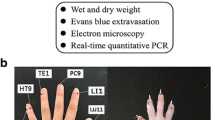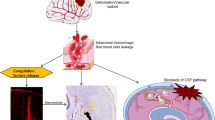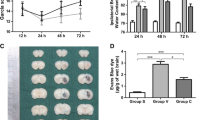Abstract
Objective
To investigate whether blood-brain barrier (BBB) served a key role in the edema-relief effect of bloodletting puncture at hand twelve Jing-well points (HTWP) in traumatic brain injury (TBI) and the potential molecular signaling pathways.
Methods
Adult male Sprague-Dawley rats were assigned to the sham-operated (sham), TBI, and bloodletting puncture (bloodletting) groups (n=24 per group) using a randomized number table. The TBI model rats were induced by cortical contusion and then bloodletting puncture were performed at HTWP twice a day for 2 days. The neurological function and cerebral edema were evaluated by modified neurological severity score (mNSS), cerebral water content, magnetic resonance imaging and hematoxylin and eosin staining. Cerebral blood flow was measured by laser speckles. The protein levels of aquaporin 4 (AQP4), matrix metalloproteinases 9 (MMP9) and mitogen-activated protein kinase pathway (MAPK) signaling were detected by immunofluorescence staining and Western blot.
Results
Compared with TBI group, bloodletting puncture improved neurological function at 24 and 48 h, alleviated cerebral edema at 48 h, and reduced the permeability of BBB induced by TBI (all P<0.05). The AQP4 and MMP9 which would disrupt the integrity of BBB were downregulated by bloodletting puncture (P<0.05 or P<0.01). In addition, the extracellular signal-regulated kinase (ERK) and p38 signaling pathways were inhibited by bloodletting puncture (P<0.05).
Conclusions
Bloodletting puncture at HTWP might play a significant role in protecting BBB through regulating the expressions of MMP9 and AQP4 as well as corresponding regulatory upstream ERK and p38 signaling pathways. Therefore, bloodletting puncture at HTWP may be a promising therapeutic strategy for TBI-induced cerebral edema.
Similar content being viewed by others
References
Gonzalez SL, Labombarda F, Gonzalez Deniselle MC, Mougel A, Guennoun R, Schumacher M, et al. Progesterone neuroprotection in spinal cord trauma involves up-regulation of brain-derived neurotrophic factor in motoneurons. J Steroid Biochem Mol Biol 2005;94:143–149.
Hiebert JB, Shen Q, Thimmesch AR, Pierce JD. Traumatic brain injury and mitochondrial dysfunction. Am J Med Sci 2015;350:132–138.
Wang WX, Visavadiya NP, Pandya JD, Nelson PT, Sullivan PG, Springer JE. Mitochondria-associated micrornas in rat hippocampus following traumatic brain injury. Exp Neurol 2015;265:84–93.
Gajavelli S, Sinha VK, Mazzeo AT, Spurlock MS, Lee SW, Ahmed AI, et al. Evidence to support mitochondrial neuroprotection, in severe traumatic brain injury. J Bioenerg Biomembr 2015;47:133–148.
Ucar T, Tanriover G, Gurer I, Onal MZ, Kazan S. Modified experimental mild traumatic brain injury model. J Trauma 2006;60:558–565.
Gajavelli S, Sinha VK, Mazzeo AT, Spurlock MS, Bullock RM. Evidence to support mitochondrial neuroprotection, in severe traumatic brain injury. J Bioenerg Biomembr 2015;47:133–148.
Hiebert JB, Shen Q, Thimmesch AR, Pierce JD. Traumatic brain injury and mitochondrial dysfunction. Am J Med Sci 2015;350:132–138.
Unterberg AW, Stover J, Kress B, Kiening KL. Edema and brain trauma. Neuroscience 2004;129:1019–1027.
Yang B, Zador Z, Verkman AS. Glial cell aquaporin-4 overexpression in transgenic mice accelerates cytotoxic brain swelling. J Biol Chem 2008;283:15280–15286.
Tang G, Yang GY. Aquaporin-4: a potential therapeutic target for cerebral edema. Int J Mol Sci 2016;17:1413.
Rabie T, Marti HH. Brain protection by erythropoietin: a manifold task. Physiology 2008;23:263–274.
Rao KV, Reddy PV, Curtis KM, Norenberg MD. Aquaporin-4 expression in cultured astrocytes after fluid percussion injury. J Neurotrauma 2011;28:371–381.
Yu NN, Wang ZG, Chen ZL, Gong YN, Guo Y. Textual research on the origination of bloodletting on Jing-well point in the medical first aid. Chin J Tradit Chin Med Pharm (Chin) 2017;32:965–968.
Tu Y, Miao XM, Yi TL, Chen XY, Sun HT, Cheng SX, et al. Neuroprotective effects of bloodletting at Jing points combined with mild induced hypothermia in acute severe traumatic brain injury. Neural Regen Res 2016;11:931–936.
Yu N, Wang Z, Chen Y, Yang J, Lu X, Guo Y, et al. The ameliorative effect of bloodletting puncture at hand twelve Jing-well points on cerebral edema induced by permanent middle cerebral ischemia via protecting the tight junctions of the blood-brain barrier. BMC Complement Altern Med 2017;17:470.
Tado M, Mori T, Fukushima M, Oshima H, Maeda T, Yoshino A, et al. Increased expression of vascular endothelial growth factor attenuates contusion necrosis without influencing contusion edema after traumatic brain injury in rats. J Neurotrauma 2014;31:691–698.
Lee ST, Et AL. Anti-inflammatory mechanism of intravascular neural stem cell transplantation in haemorrhagic stroke. Brain 2008;131:616–629.
Li B, Zhou X, Yi TL, Xu ZW, Peng DW, Guo Y, et al. Bloodletting puncture at hand twelve Jing-well points improves neurological recovery by ameliorating acute traumatic brain injury-induced coagulopathy in mice. Front Neurosci 2020;14:403.
Garling RJ, Watts LT, Sprague S, Fletcher L, Jimenez DF, Digicaylioglu M. Does progesterone show neuroprotective effects on traumatic brain injury through increasing phosphorylation of Akt in the hippocampus. Neural Regen Res 2014;9:1891–1896.
Iaccarino C, Schiavi P, Picetti E, Goldoni M, Cerasti D, Caspani M, et al. Patients with brain contusions: predictors of outcome and relationship between radiological and clinical evolution. J Neurosurg 2014;120:908–918.
Tucker B, Aston J, Dines M, Caraman E, Yacyshyn M, Mccarthy M, et al. Early brain edema is a predictor of in-hospital mortality in traumatic brain injury. J Emerg Med 2017;53:18–29.
Ding J, Guo Y. Effects of pricking blood at twelve Jing points of hand on state of consciousness in the patient of early stroke. Chin Acupunct Moxibust 2004;24:673–676.
Yu NN, Xu ZF, Gao Y, Zhou ZL, Zhao X, Zhou D, et al. Wake-promoting effect of bloodletting puncture at hand twelve Jing-well points in acute stroke patients: a multicenter randomized controlled trial. Chin J Integr Med 2020. doi: https://doi.org/10.1007/s11655-020-3093-8. Online ahead of print.
Feickert HJ, Drommer S, Heyer R. Severe head injury in children: impact of risk factors on outcome. J Trauma 1999;47:33–38.
Gatto R, Chauhan M, Chauhan N. Anti-edema effects of Rhepo in experimental traumatic brain injury. Restor Neurol Neurosci 2015;33:927–941.
Nozaki K, Nishimura M, Hashimoto N. Mitogen-activated protein kinases and cerebral ischemia. Mol Neurobiol 2001;23:1–19.
Sugino T, Nozaki K, Takagi Y, Hattori I, Hashimoto N, Moriguchi T, et al. Activation of mitogen-activated protein kinases after transient forebrain ischemia in gerbil hippocampus. J Neurosci 2000;20:4506–4514.
Zhang XM, Zhang L, Wang G, Niu W, He Z, Ding L, et al. Suppression of mitochondrial fission in experimental cerebral ischemia: the potential neuroprotective target of p38 MAPK inhibition. Neurochem Int 2015;90:1–8.
Mori T, Wang X, Aoki T, Lo Eh. Downregulation of matrix metalloproteinase-9 and attenuation of edema via inhibition of ERK mitogen activated protein kinase in traumatic brain injury. J Neurotrauma 2002;19:1411–1419.
Arai K, Lee SR, Lo EH. Essential role for ERK mitogen-activated protein kinase in matrix metalloproteinase-9 regulation in rat cortical astrocytes. Glia 2003;43:254–264.
Simard JM, Geng Z, Silver FL, Sheth KN, Kimberly WT, Stern BJ, et al. Does inhibiting Sur1 complement Rt-Pa in cerebral ischemia. Ann N Y Acad Sci 2012;1268:95–107.
Jha R, Battey TW, Pham L, Lorenzano S, Furie KL, Sheth KN, et al. Fluid-attenuated inversion recovery hyperintensity correlates with matrix metalloproteinase-9 level and hemorrhagic transformation in acute ischemic stroke. Stroke 2014;45:1040–1045.
Sheth KN, Et AL. Safety and efficacy of intravenous glyburide on brain swelling after large hemispheric infarction (Games-Rp): a randomised, double-blind, placebo-controlled phase 2 trial. Lancet Neurol 2016;15:1160–1169.
Zhao BQ, Wang S, Kim HY, Storrie H, Rosen BR, Mooney DJ, et al. Role of matrix metalloproteinases in delayed cortical responses after stroke. Nat Med 2006;12:441–445.
Chodobski A, Zink BJ, Szmydynger-Chodobska J. Blood-brain barrier pathophysiology in traumatic brain injury. Transl Stroke Res 2011;2:492–516.
Yung HW, Tolkovsky AM. Erasure of kinase phosphorylation in astrocytes during oxygen-glucose deprivation is controlled by ATP levels and activation of phosphatases. J Neurochem 2003;86:1281–1288.
Niu F, Zhang X, Chang L, Wu J, Yu Y, Chen J, et al. Trichostatin A enhances OGD-astrocyte viability by inhibiting inflammatory reaction mediated by NF-kappaB. Brain Res Bull 2009;78:342–346.
Manley GT, Fujimura M, Ma T, Noshita N, Filiz F, Bollen AW, et al. Aquaporin-4 deletion in mice reduces brain edema after acute water intoxication and ischemic stroke. Nat Med 2000;6:159–163.
Manley GT, Binder DK, Papadopoulos MC, Verkman AS. New insights into water transport and edema in the central nervous system from phenotype analysis of aquaporin-4 null mice. Neuroscience 2004;129:983–991.
Bloch O, Papadopoulos MC, Manley GT, Verkman AS. Aquaporin-4 gene deletion in mice increases focal edema associated with staphylococcal brain abscess. J Neurochem 2005;95:254–262.
Verkman AS. More than just water channels: unexpected cellular roles of aquaporins. J Cell Sci 2005;118:3225–3232.
Wilson M, Montgomery H. Impact of genetic factors on outcome from brain injury. Br J Anaesth 2007;99:43–48.
Author information
Authors and Affiliations
Contributions
Liu BH, Guo Y and Xu ZF participated in the design of the study. Liu BH, Zhou D, Guo TT, Tang HL and Chen XY carried out all of the experiments. Xu ZF and Zhang S performed the statistical analysis. Liu BH, Xu ZF, Gong YN and Guo YM drafted the manuscript and revised it. All authors have read and approved the final manuscript.
Corresponding author
Additional information
Conflict of Interest
The authors declare that they have no competing interests.
Supported by the National Natural Science Foundation of China (No. 81873369, 81704146, 81273868 and 81330088), the Tianjin Municipal Bureau of Labor and Social Security (No. 2018015)
Rights and permissions
About this article
Cite this article
Liu, Bh., Zhou, D., Guo, Y. et al. Bloodletting Puncture at Hand Twelve Jing-Well Points Relieves Brain Edema after Severe Traumatic Brain Injury in Rats via Inhibiting MAPK Signaling Pathway. Chin. J. Integr. Med. 27, 291–299 (2021). https://doi.org/10.1007/s11655-021-3326-5
Accepted:
Published:
Issue Date:
DOI: https://doi.org/10.1007/s11655-021-3326-5




